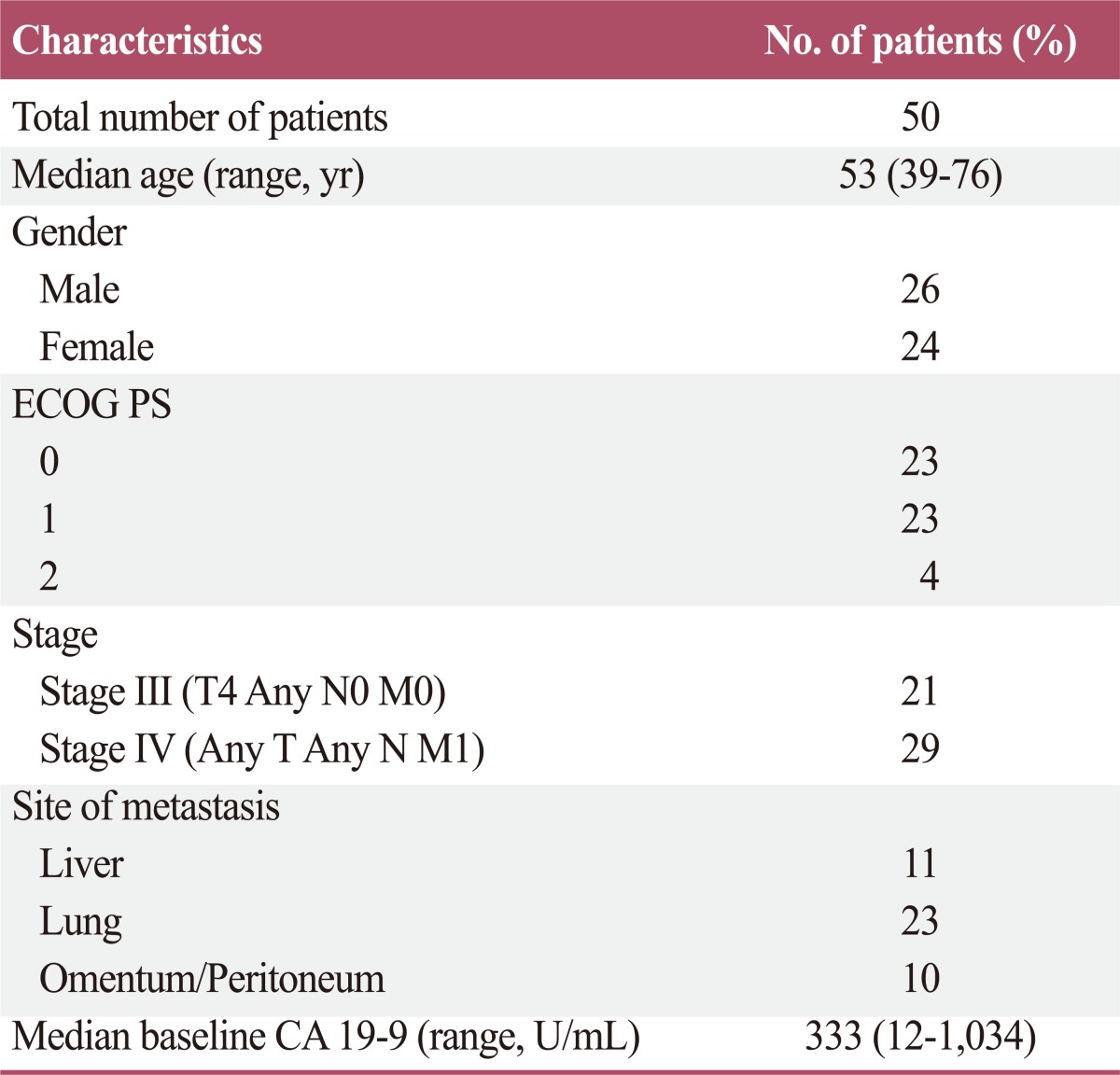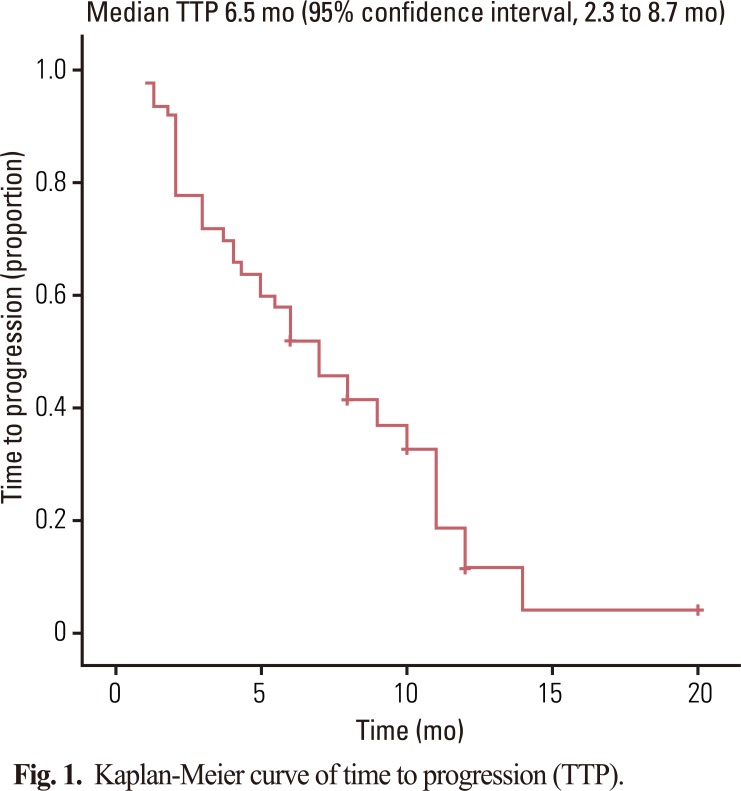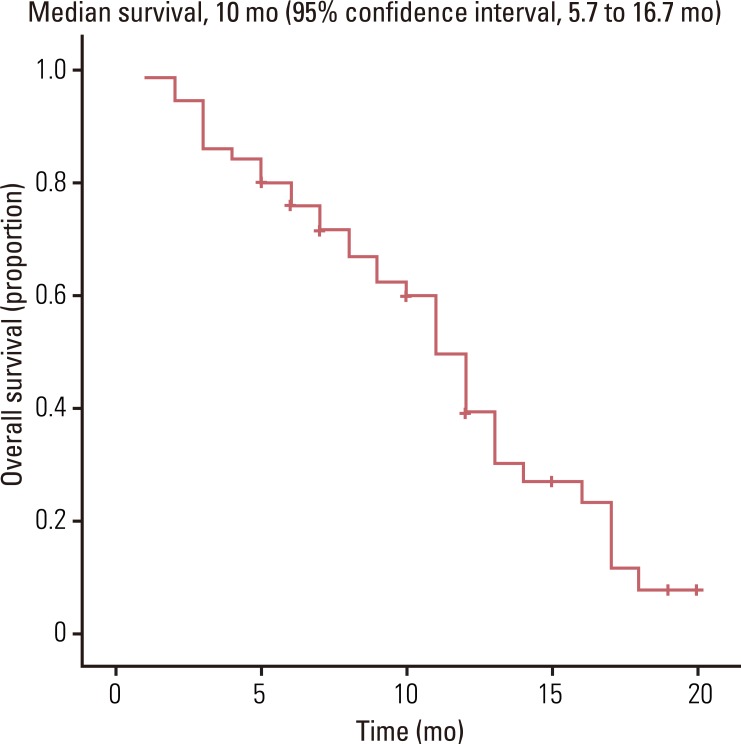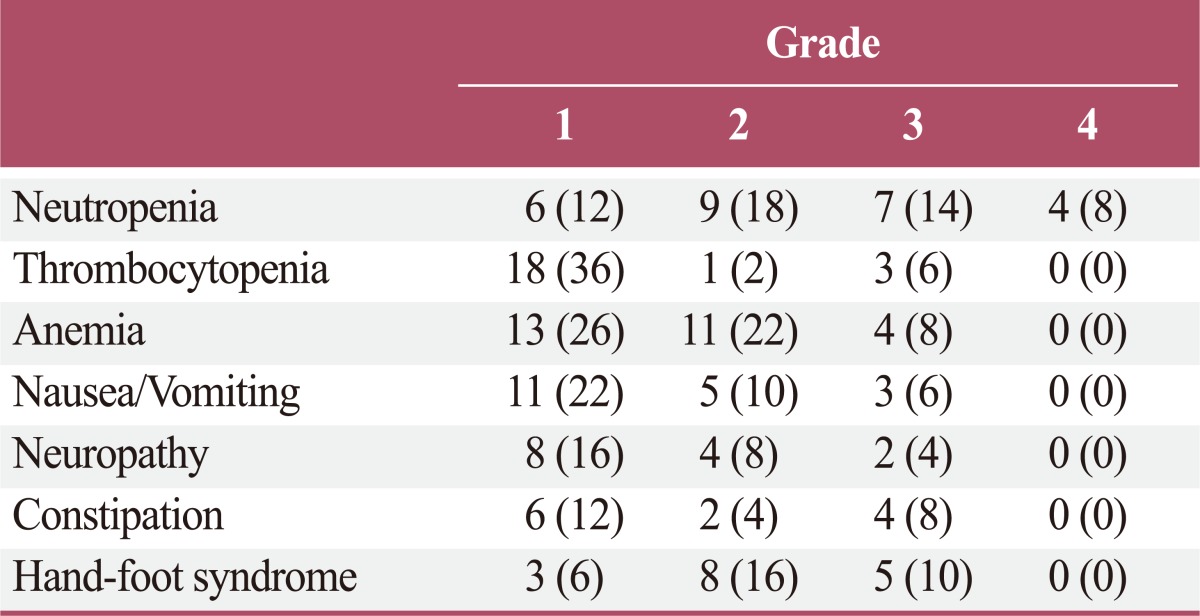Abstract
Purpose
The purpose of this study was to determine the efficacy and safety of treatment using gemcitabine and capecitabine for patients with advanced pancreatic cancer.
Materials and Methods
Patients with advanced unresectable pancreatic adenocarcinoma were enrolled in the study. Inclusion criteria included no prior systemic chemotherapy or radiation therapy, at least one radiographically documented and measurable tumor lesion, and adequate patient organ functions. The patients received 1,000 mg/m2 gemcitabine intravenously on days 1, 8 and 15, and 830 mg/m2 of oral capecitabine twice a day on days 1-21 of a 28-day cycle.
Results
Fifty patients with a median age of 53 years (range, 39 to 76 years) were enrolled in the study. The median follow-up was 10.0 months. The objective response rate of the 50 patients was 48.0% (95% CI, 22.5 to 57.1%). The median time to progression and overall survival were 6.5 months (95% CI, 2.3 to 8.7 months) and 10.0 months (95% CI, 5.7 to 16.7 months), respectively. Grade 3-4 toxicities associated with chemotherapy included neutropenia (22%), anemia (8%), thrombocytopenia (6%), and hand-foot syndrome (10%).
Conclusion
Combination chemotherapy using gemcitabine and capecitabine was well tolerated and demonstrated promising efficacy in the treatment of advanced pancreatic cancer.
Keywords: Gemcitabine, Capecitabine, Pancreatic neoplasms
Introduction
Advanced pancreatic cancer is a devastating disease. In 2008, there were 213,000 pancreatic cancer patients worldwide and most of these patients died as a result of disease progression [1]. The high mortality rate for this disease reflects typical inoperable states due to early distant metastases and ineffective treatment regimens. Fluorouracil (5-FU)-based chemotherapy has been the standard treatment for advanced pancreatic cancer, with an objective response rate of 0% to 7% [2,3]. Burris et al. [4], reported in 1997 that gemcitabine monotherapy was superior to 5-FU chemotherapy, and since that time gemcitabine has been accepted as the only effective systemic therapy. Chemoradiotherapy has not yet demonstrated improved survival benefit as compared to gemcitabine monotherapy in cases of unresectable pancreatic cancer [5].
In phase I/II clinical trials, gemcitabine and 5-FU combination chemotherapy were well tolerated and were found to be as effective as gemcitabine monotherapy [6,7]. However, no randomized studies have demonstrated that gemcitabine and 5-FU combination chemotherapy result in greater benefit than gemcitabine monotherapy.
One phase II clinical trial indicated a clinically beneficial response of 24.0% and an overall tumor response rate of 9.5% for metastatic pancreatic cancer patients treated with capecitabine [8]. As an oral precursor of 5-FU, capecitabine has a different mechanism of action than gemcitabine and no overlapping toxicities. In addition, orally administered capecitabine chemotherapy is more convenient than intravenously administered 5-FU. Thus, combination chemotherapy with gemcitabine and capecitabine has been suggested as a possible treatment for advanced pancreatic cancer patients. A combination regimen of gemcitabine and capecitabine for advanced pancreatic cancer has been evaluated in numerous clinical phase I/II trials [9-12]. Schilsky et al. [12], recommended a combination regimen consisting of a standard dose of gemcitabine (1,000 mg/m2/wk) and capecitabine (1,660 mg/m2/day for 3 weeks). In a recent phase III trial, Cunningham et al. [13], reported that capecitabine and gemcitabine combination chemotherapy involving 1,660 mg/m2/day of oral capecitabine for 3 weeks, and 1,000 mg/m2 gemcitabine by infusion on days 1, 8 and 15 every 4 weeks, significantly improved the objective response rate (19.1% vs. 12.4%; p=0.034) and progression-free survival (hazard ratio [HR], 0.78; 95% confidence interval [CI], 0.66 to 0.93; p=0.004) of patients, and was associated with a trend toward improved overall survival (OS) (HR, 0.86; 95% CI, 0.72 to 1.02; p=0.08) as compared to treatment by gemcitabine alone. However, this chemotherapy dose differed from that used in a Korean phase II study reported by Park et al. [14], in which patients were treated with 1,000 mg/m2 IV gemcitabine on days 1 and 8, and with 1,000 mg/m2 of oral capecitabine twice a day on days 1-14, in 21-day cycles.
The aim of this study was to evaluate the efficacy and toxicity of standard dose capecitabine and gemcitabine used as a first-line combination chemotherapy for the treatment of advanced pancreatic cancer in an East Asian patient sample.
Materials and Methods
1. Eligibility
Patients were enrolled in the study if they presented histologically confirmed unresectable locally advanced or metastatic adenocarcinoma of the pancreas and had no history of prior chemotherapy or radiotherapy. Additional inclusion criteria included: age 18-80 years, performance status of 0-2 following the Eastern Cooperative Oncology Group (ECOG), life expectancy >3 months, and at least one radiographically documented measurable lesion in a previously non-irradiated area. According to the Response Evaluation Criteria in Solid Tumors (RECIST), the lesion must be adequately measurable by spiral computed tomography scan in at least one dimension ≥1 cm. There must also be adequate organ and marrow function as indicated by absolute neutrophil count (≥1,500 cells/mm3), platelet count (≥100,000 cells/mm3), and total bilirubin (<3 mg/dL) and creatinine (≤1.6 mg/dL).
Exclusion criteria were as follows: brain metastasis, known hypersensitivity to capecitabine or gemcitabine, and treatment in another clinical study within the past 30 days. All patients were required to provide informed consent prior to study enrollment. The protocol and informed consent form were approved by our Institutional Review Board.
2. Treatment protocol
Patients received gemcitabine and capecitabine combination therapy consisting of 1,000 mg/m2 gemcitabine via intravenous infusion over 30 minutes on days 1, 8 and 15, and 1,660 mg/m2/day of oral capecitabine on days 1-21, every 4 weeks. This treatment continued until RECIST-defined progressive disease was established, development of cumulative toxic effects were observed, or if the patients chose to discontinue treatment. Five dose levels of capecitabine were established according to the patient body surface area (BSA) as follows: BSA<1.39 m2, 1,000 mg twice a day; BSA 1.40-1.75 m2, 1,300 mg twice a day; BSA 1.76-1.90 m2, 1,500 mg twice a day; BSA 1.91-2.09 m2, 1,650 mg twice a day; BSA>2.09 m2, 1,800 mg twice a day. The BSA was required to be recalculated and the gemcitabine and capecitabine dose adapted accordingly prior to each cycle. If patients had an absolute neutrophil count <1,000 cells/mm3, platelet count<70,000 cells/mm3, or unacceptable non-hematological toxicities (>grade 1), the start of the next cycle chemotherapy was delayed up to 2 weeks in order to allow for recovery. However, if the toxicity continued for 2 weeks, one or both of the chemotherapeutic agents were discontinued. If the start of the next cycle was delayed due to either gemcitabine or capecitabine-related toxicities, the start of treatment with the other compound was also postponed. If either the gemcitabine or capecitabine dose was permanently discontinued, treatment with the remaining acceptable compound was continued according to the schedule. In cases of febrile neutropenia, the gemcitabine and capecitabine doses were reduced by 25%. The dose of capecitabine was also reduced by 25% in cases of grade≥3 hand-foot syndrome, mucositis or diarrhea.
3. Assessments
Physical and laboratory examinations were performed one day prior to chemotherapy. We also evaluated chest X-ray and electrocardiogram results prior to initiation of chemotherapy, and repeated abdomen and chest computerized tomography examination every eight weeks. The objective tumor response was evaluated according to the RECIST criteria, ver. 1.0. Carbohydrate antigen 19-9 and chorioembryonic antigen were evaluated every two cycles. Toxicities were defined according to the National Cancer Institute's common toxicity criteria, ver. 3.0.
4. Statistical analysis
This study was designed as an extended, two-step, phase II study. The sample size was calculated in order to reject a 20% response rate in favor of a target response rate of 40%, with a significance level of 0.05 and a power of 80% using Simon's optimal two-stage design. In the initial stage, 13 evaluable patients entered treatment and were evaluated for response. If there were fewer than four responses the study was to be terminated. If more than five responses were observed in the first stage, then 30 additional patients were to enter treatment in the second stage in order to achieve a target sample size of 43 evaluable patients.
The primary end point of the study was response rate with the secondary end points being toxicities associated with the regimen. The objective response rate was defined as the proportion of patients with complete responses (CR) and partial responses (PR) as measured by spiral computer tomography. Time to progression (TTP) was defined as the time from the start of chemotherapy to the date of documented disease progression. OS was calculated from the starting date of chemotherapy to the date of death, regardless of cause. Surviving patients were counted for OS on the date they were last known to be alive. TTP and OS were analyzed by the Kaplan-Meier method. The statistical significance of the difference in each group was evaluated using the log-rank test. p-values < 0.05 were considered to be statistically significant. Data were calculated using the SPSS ver. 13.0 (SPSS Inc., Chicago, IL).
Results
1. Patient characteristics
Fifty patients who were treated at the Korea University Guro Hospital were enrolled in this phase II trial from March 2007 to December 2009. Patient characteristics are shown in Table 1. The median age was 53 years (range, 39 to 76 years) and 26 men and 24 women participated. All patients had an ECOG performance status of 0-2. Twenty-nine patients had metastatic lesions and 21 had an unresectable locally advanced lesion. The median number of chemotherapy cycles administered was five (range, 1 to 19).
Table 1.
Patient characteristics
ECOG PS, Eastern Cooperative Oncology Group performance status; CA 19-9, carbohydrate antigen 19-9.
2. Response to treatment and survival results
Responses were analyzed on an intention-to-treat basis. Out of the total 50 patients, there were no CR, 24 (48%) were confirmed PR and 20 (40%) were observed with stable disease. Progressive disease occurred in six of the 50 patients (12%). Objective responses were observed in 24 out of 50 patients (CR+PR, 48%; 95% CI, 22.5 to 57.1%). These results are shown in Table 2. The median follow up time for all patients was 10.0 months (95% CI, 5.7 to 16.7 months). Median TTP was 6.5 months (95% CI, 2.3 to 8.7 months) (Fig. 1). Median OS was 10 months (95% CI, 5.7 to 16.7 months) and the 1-year survival rate was 45% (Fig. 2). The overall median survival was 11.5 months (95% CI, 8.68 to 14.0 months) for stage III disease and 9.4 months (95% CI, 3.56 to 14.2 months) for stage IV. However, there was no significant survival difference between the two stages (p=0.24).
Table 2.
Objective response to treatment
Fig. 1.
Kaplan-Meier curve of time to progression (TTP).
Fig. 2.
Kaplan-Meier curve of overall survival.
3. Toxicities
Therapy-related toxicities were monitored in all 50 patients who were treated with 1,000 mg/m2 gemcitabine and 1,660 mg/m2 of oral capecitabine, as shown in Table 3. The most common toxicity was anemia (56%). Grade 3/4 neutropenia developed in 11 patients (22%). Three patients (6%) had neutropenic fever but recovered without complications. The patients with neutropenic fever were subsequently treated with a 25% reduced dosage of chemotherapeutic agents if they were to start the next cycle of chemotherapy. Non-hematologic side effects were relatively mild. Grade 3/4 neuropathy occurred in two patients (4%) and grade 3/4 constipation in four patients (8%). Although five patients (10%) had grade 3/4 hand-foot syndrome, the treatment for the toxic symptoms was effective in all cases.
Table 3.
Toxicities resulting from chemotherapy
Values are presented as number (%).
Discussion
Gemcitabine is currently the standard chemotherapy for unresectable pancreatic cancer. In some studies, the median survival duration following gemcitabine monotherapy was only 5.7-6.3 months and the response rate was only 5.0-11.0% [4,15]. These poor outcomes clearly indicated the need for more effective treatment strategies for advanced pancreatic cancer.
Although some trials of combination therapies including gemcitabine and other cytotoxic agents, such as irinotecan and oxaliplatin, resulted in improved response rates over gemcitabine monotherapy, randomized phase III trials of these combinations have shown no significant survival benefits [16,17]. Other phase III studies have reported negative results with no demonstration of improved efficacy for combinations of gemcitabine with the cytotoxic agents exatecan and pemetrexed, and the targeted agent tipifarnib [18-20].
In a randomized phase III study comparing the combination of gemcitabine and capecitabine with gemcitabine as a single agent, Cunningham et al. [13], observed a significant increase in progression free survival (HR, 0.78; 95% CI, 0.66 to 0.93; p=0.004), an increased response rate (19.1% vs. 12.4%; p=0.034), and a trend toward improved OS benefit (HR, 0.86; 95% CI, 0.72 to 1.02; p=0.08) for the combination arm of the study. In contrast, Herrmann et al. [21], previously reported no difference in the OS rate or efficacy of combination chemotherapy using gemcitabine and capecitabine as compared to gemcitabine alone. However, the schedule and dose intensity of gemcitabine and capecitabine differed between these studies. In the former study, which showed a trend toward an improved OS benefit in the combination chemotherapy group, patients received 1,660 mg/m2/day of oral capecitabine for 3 weeks, and 1,000 mg/m2 gemcitabine by infusion on days 1, 8 and 15, every 4 weeks. In the latter study, patients received 650 mg/m2 of oral capecitabine twice daily on days 1 to 14, and 1,000 mg/m2 of gemcitabine by 30-minute infusion on days 1 and 8, every 3 weeks. This difference indicated that the dose-intense combination regimen was more effective than the other regimen.
The results of our study of gemcitabine and capecitabine combination therapy produced an overall response rate (CR+PR) of 48% and a median TTP and OS of 6.5 and 10.0 months, respectively. These results were similar to those of Park et al. [14], who reported a phase II combination therapy study that consisted of 1,000 mg/m2 gemcitabine on days 1 and 8, and 1,000 mg/m2 of capecitabine twice each day on days 1-14, every 3 weeks. This design achieved an objective response rate of 40%, and a median TTP and OS of 5.4 and 10.4 months, respectively [14]. Although our study utilized a different capecitabine dose than the study by Park et al. [14], both studies showed comparable response and OS rates in an East Asian patient sample.
The gemcitabine and capecitabine combination regimen used in this study was generally tolerable in regards to toxicities. Grade 3/4 neutropenia was reported in eleven patients (22%). Other major grade 3/4 adverse events included anemia (8%), thrombocytopenia (6%) and hand-foot syndrome (10%). This toxicity profile was similar to that observed by Park et al. [14], and in other previous studies. Although the incidence of grade 3/4 hand-foot syndrome was higher than in other studies, the condition was generally well controlled. No patients dropped out of the present study due to hand-foot syndrome.
A recent paper illustrates the increasing body of knowledge concerning the molecular biological mechanisms associated with pancreatic cancer and suggests new therapeutic approaches. Pancreatic cancer growth is deregulated by manipulation of the epidermal growth factor receptor (EGFR) signaling pathway [22]; Moore et al. [23], evaluated the effectiveness of the EGFR inhibitor, erlotinib, in treating patients with advanced pancreatic cancer in a phase III trial which compared gemcitabine plus erlotinib with gemcitabine monotherapy. The results revealed a significant benefit in terms of OS in the erlotinib combination arm of the trial (HR, 0.82; p=0.038) [23]; however, the median progression free survival was only 3.7 months and the OS was 6.4 months. These results were not clinically promising outcomes. Moreover, Philip et al. [24], reported that there was no additional benefit in numerous phase III trials which compared gemcitabine combined with other cytotoxic drugs with gemcitabine alone. They emphasized the need for well-designed phase II studies with a uniform set of basic entry and evaluation criteria with survival as a primary endpoint [24].
Therefore, although our study had the limitation of being a single center study with a small sample of enrolled patients, our results were encouraging when compared to those of other studies.
Conclusion
A clinical study of dose-lessened capecitabine and gemcitabine combination therapy was associated with an effective response rate and delayed TTP in an East Asian patient sample. Furthermore, the toxicities associated with the treatment were well tolerated and the regimen was relatively convenient to administer. Our study results suggested that this dose-intensity of gemcitabine and capecitabine combination therapy can be offered as a first-line option in cases of locally advanced and/or metastatic pancreatic cancer. However, these findings should be further validated through a larger phase III trial in an East Asian patient sample.
Footnotes
Conflicts of interest relevant to this article was not reported.
References
- 1.Koorstra JB, Hustinx SR, Offerhaus GJ, Maitra A. Pancreatic carcinogenesis. Pancreatology. 2008;8:110–125. doi: 10.1159/000123838. [DOI] [PMC free article] [PubMed] [Google Scholar]
- 2.Storniolo AM, Enas NH, Brown CA, Voi M, Rothenberg ML, Schilsky R. An investigational new drug treatment program for patients with gemcitabine: results for over 3000 patients with pancreatic carcinoma. Cancer. 1999;85:1261–1268. [PubMed] [Google Scholar]
- 3.Cullinan S, Moertel CG, Wieand HS, Schutt AJ, Krook JE, Foley JF, et al. A phase III trial on the therapy of advanced pancreatic carcinoma. Evaluations of the Mallinson regimen and combined 5-fluorouracil, doxorubicin, and cisplatin. Cancer. 1990;65:2207–2212. doi: 10.1002/1097-0142(19900515)65:10<2207::aid-cncr2820651007>3.0.co;2-y. [DOI] [PubMed] [Google Scholar]
- 4.Burris HA, 3rd, Moore MJ, Andersen J, Green MR, Rothenberg ML, Modiano MR, et al. Improvements in survival and clinical benefit with gemcitabine as first-line therapy for patients with advanced pancreas cancer: a randomized trial. J Clin Oncol. 1997;15:2403–2413. doi: 10.1200/JCO.1997.15.6.2403. [DOI] [PubMed] [Google Scholar]
- 5.Barhoumi M, Mornex F, Bonnetain F, Rougier P, Mariette C, Bouché O, et al. Locally advanced unresectable pancreatic cancer: induction chemoradiotherapy followed by maintenance gemcitabine versus gemcitabine alone: definitive results of the 2000-2001 FFCD/SFRO phase III trial. Cancer Radiother. 2011;15:182–191. doi: 10.1016/j.canrad.2010.10.001. [DOI] [PubMed] [Google Scholar]
- 6.Oettle H, Arning M, Pelzer U, Arnold D, Stroszczynski C, Langrehr J, et al. A phase II trial of gemcitabine in combination with 5-fluorouracil (24-hour) and folinic acid in patients with chemonaive advanced pancreatic cancer. Ann Oncol. 2000;11:1267–1272. doi: 10.1023/a:1008364018881. [DOI] [PubMed] [Google Scholar]
- 7.Matano E, Tagliaferri P, Libroia A, Damiano V, Fabbrocini A, De Lorenzo S, et al. Gemcitabine combined with continuous infusion 5-fluorouracil in advanced and symptomatic pancreatic cancer: a clinical benefit-oriented phase II study. Br J Cancer. 2000;82:1772–1775. doi: 10.1054/bjoc.1999.1139. [DOI] [PMC free article] [PubMed] [Google Scholar]
- 8.Cartwright TH, Cohn A, Varkey JA, Chen YM, Szatrowski TP, Cox JV, et al. Phase II study of oral capecitabine in patients with advanced or metastatic pancreatic cancer. J Clin Oncol. 2002;20:160–164. doi: 10.1200/JCO.2002.20.1.160. [DOI] [PubMed] [Google Scholar]
- 9.Stathopoulos GP, Syrigos K, Polyzos A, Fountzilas G, Rigatos SK, Ziras N, et al. Front-line treatment of inoperable or metastatic pancreatic cancer with gemcitabine and capecitabine: an intergroup, multicenter, phase II study. Ann Oncol. 2004;15:224–229. doi: 10.1093/annonc/mdh065. [DOI] [PubMed] [Google Scholar]
- 10.Hess V, Salzberg M, Borner M, Morant R, Roth AD, Ludwig C, et al. Combining capecitabine and gemcitabine in patients with advanced pancreatic carcinoma: a phase I/II trial. J Clin Oncol. 2003;21:66–68. doi: 10.1200/JCO.2003.04.029. [DOI] [PubMed] [Google Scholar]
- 11.Scheithauer W, Schüll B, Ulrich-Pur H, Schmid K, Raderer M, Haider K, et al. Biweekly high-dose gemcitabine alone or in combination with capecitabine in patients with metastatic pancreatic adenocarcinoma: a randomized phase II trial. Ann Oncol. 2003;14:97–104. doi: 10.1093/annonc/mdg029. [DOI] [PubMed] [Google Scholar]
- 12.Schilsky RL, Bertucci D, Vogelzang NJ, Kindler HL, Ratain MJ. Dose-escalating study of capecitabine plus gemcitabine combination therapy in patients with advanced cancer. J Clin Oncol. 2002;20:582–587. doi: 10.1200/JCO.2002.20.2.582. [DOI] [PubMed] [Google Scholar]
- 13.Cunningham D, Chau I, Stocken DD, Valle JW, Smith D, Steward W, et al. Phase III randomized comparison of gemcitabine versus gemcitabine plus capecitabine in patients with advanced pancreatic cancer. J Clin Oncol. 2009;27:5513–5518. doi: 10.1200/JCO.2009.24.2446. [DOI] [PubMed] [Google Scholar]
- 14.Park BB, Park JO, Lee HR, Lee J, Choi DW, Choi SH, et al. A phase II trial of gemcitabine plus capecitabine for patients with advanced pancreatic adenocarcinoma. Cancer Chemother Pharmacol. 2007;60:489–494. doi: 10.1007/s00280-006-0390-7. [DOI] [PubMed] [Google Scholar]
- 15.Carmichael J, Fink U, Russell RC, Spittle MF, Harris AL, Spiessi G, et al. Phase II study of gemcitabine in patients with advanced pancreatic cancer. Br J Cancer. 1996;73:101–105. doi: 10.1038/bjc.1996.18. [DOI] [PMC free article] [PubMed] [Google Scholar]
- 16.Rocha Lima CM, Green MR, Rotche R, Miller WH, Jr, Jeffrey GM, Cisar LA, et al. Irinotecan plus gemcitabine results in no survival advantage compared with gemcitabine monotherapy in patients with locally advanced or metastatic pancreatic cancer despite increased tumor response rate. J Clin Oncol. 2004;22:3776–3783. doi: 10.1200/JCO.2004.12.082. [DOI] [PubMed] [Google Scholar]
- 17.Louvet C, Labianca R, Hammel P, Lledo G, Zampino MG, André T, et al. Gemcitabine in combination with oxaliplatin compared with gemcitabine alone in locally advanced or metastatic pancreatic cancer: results of a GERCOR and GISCAD phase III trial. J Clin Oncol. 2005;23:3509–3516. doi: 10.1200/JCO.2005.06.023. [DOI] [PubMed] [Google Scholar]
- 18.Abou-Alfa GK, Letourneau R, Harker G, Modiano M, Hurwitz H, Tchekmedyian NS, et al. Randomized phase III study of exatecan and gemcitabine compared with gemcitabine alone in untreated advanced pancreatic cancer. J Clin Oncol. 2006;24:4441–4447. doi: 10.1200/JCO.2006.07.0201. [DOI] [PubMed] [Google Scholar]
- 19.Oettle H, Richards D, Ramanathan RK, van Laethem JL, Peeters M, Fuchs M, et al. A phase III trial of pemetrexed plus gemcitabine versus gemcitabine in patients with unresectable or metastatic pancreatic cancer. Ann Oncol. 2005;16:1639–1645. doi: 10.1093/annonc/mdi309. [DOI] [PubMed] [Google Scholar]
- 20.Van Cutsem E, van de Velde H, Karasek P, Oettle H, Vervenne WL, Szawlowski A, et al. Phase III trial of gemcitabine plus tipifarnib compared with gemcitabine plus placebo in advanced pancreatic cancer. J Clin Oncol. 2004;22:1430–1438. doi: 10.1200/JCO.2004.10.112. [DOI] [PubMed] [Google Scholar]
- 21.Herrmann R, Bodoky G, Ruhstaller T, Glimelius B, Bajetta E, Schüller J, et al. Gemcitabine plus capecitabine compared with gemcitabine alone in advanced pancreatic cancer: a randomized, multicenter, phase III trial of the Swiss Group for Clinical Cancer Research and the Central European Cooperative Oncology Group. J Clin Oncol. 2007;25:2212–2217. doi: 10.1200/JCO.2006.09.0886. [DOI] [PubMed] [Google Scholar]
- 22.Harsha HC, Jimeno A, Molina H, Mihalas AB, Goggins MG, Hruban RH, et al. Activated epidermal growth factor receptor as a novel target in pancreatic cancer therapy. J Proteome Res. 2008;7:4651–4658. doi: 10.1021/pr800139r. [DOI] [PubMed] [Google Scholar]
- 23.Moore MJ, Goldstein D, Hamm J, Figer A, Hecht JR, Gallinger S, et al. Erlotinib plus gemcitabine compared with gemcitabine alone in patients with advanced pancreatic cancer: a phase III trial of the National Cancer Institute of Canada Clinical Trials Group. J Clin Oncol. 2007;25:1960–1966. doi: 10.1200/JCO.2006.07.9525. [DOI] [PubMed] [Google Scholar]
- 24.Philip PA, Mooney M, Jaffe D, Eckhardt G, Moore M, Meropol N, et al. Consensus report of the national cancer institute clinical trials planning meeting on pancreas cancer treatment. J Clin Oncol. 2009;27:5660–5669. doi: 10.1200/JCO.2009.21.9022. [DOI] [PMC free article] [PubMed] [Google Scholar]







